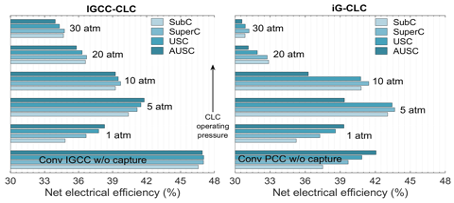2020 Virtual AIChE Annual Meeting
(364h) Coupling Chemical Looping Combustion of Solid Fuels with Advanced Steam Cycles for CO2 Capture: A Process Modelling Study
Author
Wen Liu - Presenter, Nanyang Technological University
Chemical looping combustion (CLC) is a cost-effective solution for producing affordable low carbon electricity. In this paper, we present a systematic process modelling study concerning the coupling of CLC of solid fuels with advanced steam-based power cycles, viz. supercritical, ultra-supercritical and advanced ultra-supercritical Rankine cycles. Our models differentiate from previously process modelling studies by incorporating in practical considerations for heat management. The energy efficiency of the various CLC-based power plant configurations are compared against the reference plants in the absence of carbon capture. We recognise that the key practical constraint to the efficiencies of CLC power plants is the maximum operating temperature of the oxygen carriers. By assuming an upper operating temperature limit of 950 â¦C, the modelling results suggest that the CLC power plants are the most efficient when the CLC reactors operate at 5 atm. Under optimal conditions, the energy efficiencies, based on LHV of coal, are 42.11% and 40.64% for in situ gasification â CLC (iG-CLC) and integrated gasification combined cycle CLC (IGCC-CLC) power plants, respectively. Overall, the energy efficiency penalties for capturing carbon from subcritical, supercritical, ultra-supercritical and advanced ultra-supercritical steam cycles by iG-CLC are 4.46%, 4.36%, 4.60% and 8.56%, respectively, assuming IGCC without carbon capture as the base plant. The corresponding efficiency penalties for IGCC-CLC are 5.93%, 6.03%, 5.73% and 5.35%, respectively. Therefore, iG-CLC appears to be the most cost-effective process configuration for power generation with simultaneous carbon capture. The application of biomass CLC was also evaluated and has shown performance comparable to that of the coal-fired CLC plants. Our findings suggest opportunities for CLC to remain an attractive carbon capture technology for power generation from solid fuels in a future when ultra-supercritical steam cycles has became the norm.


